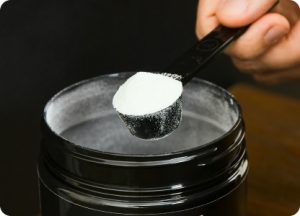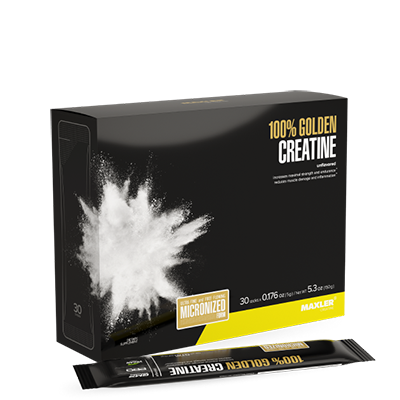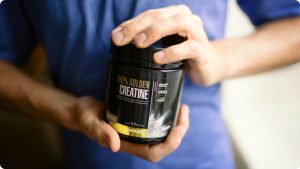Are you looking to grow your muscles in an efficient manner? Or just get better at explosive movements? If so, creatine can be something to consider. Creatine is a popular supplement; you’ll probably have heard fitness influencers discussing it. If you’re looking to understand what creatine is and what it does, you’ve come to the right place. We’ll cover everything you need to know about creatine in this post.
What is creatine?
Starting off, what on earth is creatine?
Creatine is an amino acid. It is made from three other amino acids: glycine, arginine and methionine.
However, in contrast to the amino acids you might take as a supplement or you might get from foods and protein shakes, it doesn’t make up our muscles. Instead, it has another function.
Creatine plays a role in the energy production processes of the cells. Our cells use a particular type of chemical energy to power themselves. This energy is stored inside molecules called adenosine triphosphate, or ATP. ATP is made up of a sugar, a nitrogenous base, and three phosphate groups. It is able to “hold” the energy in a bond between the phosphate groups. When the cell needs energy, it releases energy from ATP. This happens through the breaking of the bond between phosphate groups.
The process leaves an “empty” ADP molecule. Chemically, it is the same as ATP, just missing that extra phosphate. But our body needs a way to remake ATP, and it needs to do so fast. Since we have ADP, which can provide us with the proper precursor, we just need to find a way to get a phosphate on there.
This is where the so-called phosphocreatine system comes in. Our muscles have a quick mechanism for replenishing the phosphate. Creatine molecules can carry phosphate in the form of phosphocreatine or creatine phosphate. The creatine can then pass on the phosphate onto ADP, energizing it. And suddenly, you’ve got ATP to help the cells do what they need to!
Once the phosphocreatine is used up, it is turned into creatinine and is excreted.
It’s a lot of science to wrap your head around. In summary, creatine is used by the body as a way to quickly replenish energy. This comes in handy during times when you’re exercising, which is why it’s very popular with athletes.
Benefits of taking creatine
What does research tell us about creatine supplements? Are there any benefits from creatine?
It wouldn’t be as popular as it is if there wasn’t any benefit to creatine as a supplement. In fact, up to 75% of athletes use it. It’s one of the most popular supplements worldwide.
So, what can creatine help you with?
Creatine is probably best known amongst those who resistance train.
It allows you to increase the number of sets you can do. This is helpful in providing enough stimulus to the muscle for optimal growth. It can increase one rep max, supporting those high-intensity muscle contractions. Creatine can help boost muscle mass and strength, which most people taking creatine want. It may be able to increase growth hormone, which is crucial for stimulating muscle growth.
In addition, creatine can benefit sprint performance. This can be especially important for those who play sports like hockey and soccer, where sprints are a vital part of the game.
However, endurance athletes shouldn’t overlook creatine either. Creatine can benefit the endurance athlete in multiple ways:
- It can help quickly replenish ATP stores during exercise.
- If taken with carbohydrates, it is very effective at remaking glycogen. This is key for recovery and helps support high-intensity aerobic training.
- It can lower inflammation and support mitochondrial function.
- It can benefit those who rely on a final sprint at the end of the race, as it supports high-intensity spurts. Alternatively, it can benefit those who need to change their intensity multiple times during a race.
However, endurance athletes should keep in mind that creatine can increase muscle mass and, therefore, weight. For certain types of sports, that may be a slight disadvantage. Talk to your coach or your team doctor if you’re considering creatine to evaluate all the pros and cons.
If you struggle with recovery, creatine may be able to help. Supplementing after exercise can lower the damage that the muscles experience. In addition, creatine may be able to decrease inflammation in muscles.
If recovery is not your strong suit, but you’d like to improve it, we have some helpful posts for you, such as:
- How to support recovery after your workout
- What to do with DOMS – delayed onset muscle soreness
- Top 3 techniques for recovering after a workout
Creatine may help athletes recover from injury. While it’s unclear how, people taking creatine tend to experience less injury. They can also recover quicker and get back into the swing of things even after not working out for an extended period of time.
Creatine may be able to support those who exercise or compete in the heat. This is likely due to its ability to help athletes hyper-hydrate. Therefore, if you’re exercising when it’s hot or your competitive season falls into the summer, creatine may be a supplement to support your performance.
However, muscles aren’t the only part of the body that can benefit from creatine. There’s been a rise in studies looking at how creatine supports other aspects of health.
Creatine is part of our cellular energy system. It is, therefore, essential for the organs that use up a lot of energy. And which organs use plenty of energy? The brain, the liver, the kidneys and even the testes! Consistent creatine intake can increase creatine levels in the brain.
Creatine may benefit the body in the following ways:
- Supporting cardiovascular health. Old studies suggest that it can help with blood lipid control for those with a mild case of high blood content. It may also lower the amount of homocysteine, which is associated with issues connected to heart health.
- Supporting brain activity. It can improve cognitive functions for prolonged periods of time.
- Supporting cognitive functions. Creatine may also improve or support skill execution, memory, cognition and the capacity for work in various people, from healthy volunteers to the elderly. This may be especially useful for those who may not be sleeping enough.
- It may support mood. Some studies report ameliorating low moods or nervousness, which can benefit those prone to these feelings.
How much creatine do I need per day?
The amount of creatine you’ll need will depend on a few factors. Typically, an average person requires around 2 grams every day. We can make half of that by ourselves, as creatine can be made in the body. The rest will usually come from foods if you’re on an omnivore diet.
However, if you’re supplementing creatine, your requirements might look different. Athletes will typically consume 3-10g of creatine a day. In contrast, certain people may have to consume up to 30 grams of creatine a day! It’s worth noting that vegans and vegetarians will typically be unable to get much creatine from foods, and they may benefit from slightly higher dosages if supplementing.
What foods have a lot of creatine?
Many of us would like to help ourselves get into great shape by mainly relying on whole foods. It’s an excellent approach to support good health while working toward your goals. So, naturally, you might wonder whether you can get sufficient creatine from foods.
Food sources do contain creatine. Foods rich in creatine include cod, beef, herring, pork, milk, and salmon. Creatine is mainly found in animal products, making it hard for vegetarians and vegans to get creatine from food.
However, the good news is that our body is also able to make creatine on its own. We can make creatine from three amino acids – glycine, methionine and arginine. Therefore, vegans and vegetarians will have to rely on supplements or on their body’s ability to make creatine. Providing the body with the amino acids can support the synthesis.
However, for those wanting to get additional creatine, supplements are the best way to do so. If you’re choosing a creatine supplement, there are a few things to consider:
- Type of creatine. There are different types of creatine available on the market. Creatine monohydrate is one of the most common ones. Choose one that fits into your goals and your budget.
- Form of creatine. Creatine can come in many forms. Some supplements contain creatine powder. Others have creatine in the form of a pill. For many, creatine powder will be an ideal form, as it allows you to personalize your dosage depending on your goals.
- Convenience. For athletes who are interested in taking creatine but travel a lot, convenience may be a key concern. When you’re travelling, carrying large cans can be inconvenient. You may prefer a sachet form instead. For example, Maxler 100% Golden Creatine comes in 5g sachets that are easy to put into your bag.
- Additional ingredients. Some people may want to take the creatine together with other ingredients. Creatine monohydrate is a part of many pre-workout supplements. Alongside it, you can find vitamins, minerals, caffeine or other ingredients known to support energy levels. Alternatively, the dosage in a conventional pre-workout may not be sufficient for your purposes. Consider whether you want a creatine supplement with additional ingredients or creatine on your own.
- Quality. One of the most important aspects of a supplement is its quality. After all, you wouldn’t want to pay for creatine and get a load of filler instead. Therefore, choose brands that are open about their quality standards. For example, Maxler produces supplements in GMP and IFS-certified factories. This means that they follow the highest quality standards during manufacturing. If you can, choose supplements which have been additionally tested.
Now that you know how to choose a creatine supplement, let’s dive into more details on the available creatine types.
Types of creatine
There are many types of creatine available on the market. But finding your ideal creatine supplement and not being mis-sold something that’s not as effective is not easy. Therefore, let’s take a look at the different types of creatine available:
- Creatine monohydrate. This is the most common form of the supplement and is also the most researched. It’s usually used in scientific studies. It can exist in multiple forms. There’s the classic creatine monohydrate. There’s also anhydrous creatine, which is creatine without water. It’s a higher concentration of creatine, as creatine monohydrate has about 10% of water by weight. Finally, there’s micronized creatine. This form of creatine has better solubility. Maxler 100% Golden Creatine contains micronized creatine, so you can mix it in your water bottle with no problem.
- Creatine hydrochloride. You may find it called creatine HCl as well. This form of creatine is attached to hydrochloric acid. This is supposed to enhance its absorption. It can dissolve better than creatine monohydrate. However, whether it’s more effective than the original has yet to be seen.
- Creatine ethyl ester. This form of creatine is attached to ester salts. This should make it more easily absorbed in the body. In practice, however, it doesn’t seem to reach the blood and muscles as effectively. Therefore, creatine monohydrate is probably a better option than the ethyl ester.
- Buffered creatine, known as Kre-Alkalyn. Buffered creatine has a higher pH. The reason for this is because it is processed with an alkali during production. This makes it more stable in the stomach and may reduce discomfort with creatine use. It is as effective as creatine monohydrate. However, the form is “more concentrated,” whereby you can use smaller amounts of Kre-Alkalyn to get the same effect as from a large amount of creatine monohydrate. If you’re not a big fan of taking large doses of creatine, Kre-Alkalyn might be for you.
- Creatine Magnesium Chelate. This form of creatine is attached to magnesium. The reason was the same as in previous products: to increase absorbance and bioavailability. However, whether it works in this way is still under question.
- Liquid creatine. Liquid creatine may sound like a good idea if you don’t want to bother with powders. However, there may be a caveat with this. Liquid creatine seems to break down after a few days. That means you’ll be getting less creatine. Less creatine means fewer results. Therefore, it’s probably best to mix your own creatine.
Remember that the best creatine is the creatine supplement that works for you and one you can take regularly. Don’t just go for something that’s marketed to be the best creatine for men or women. Experiment and find a supplement that truly works for you.
How to use creatine for muscle growth
If your main goal is to grow muscle, then creatine can be the right supplement for you.
However, before getting to creatine, there are a few things that must be in place:
- Are you in a calorie surplus? Growing muscle takes energy, so you need to ensure that your current calorie intake allows the extra energy for the process.
- Are you getting sufficient protein? There’s no point in adding in creatine if you’re not providing the body with the building blocks it requires. Therefore, make sure you’re getting enough protein during the day. In addition, pay attention to the timing of your protein intake. Get protein regularly, every few hours. If you can, consider protein before bed as well to promote muscle synthesis even as you sleep.
- Do you have healthy food habits? Nutrition is important for optimizing performance and muscle growth. Providing the body with the right vitamins and minerals can support critical cellular processes that happen during muscle building.
- Are you on a consistent training schedule? Muscle needs a stimulus to grow. The best way to provide that stimulus is through strength training. Ensure you’re hitting the gym regularly before and during your muscle-building phase.
- Are you challenging yourself? Ever heard of progressive overload? You need to challenge the muscle to help it grow. Make sure your sets are hard enough when working out.
- Are you getting enough sleep and recovering correctly? Recovery is as important in building muscle as exercise. Therefore, ensuring that you’re sleeping enough is essential for muscle growth.
If you’re happy that all of these factors are in place, then you can start bringing in creatine. If not, you might find our range of articles helpful. Topics we cover include:
- How amino acids support your muscle growth
- How to drink gainers and protein powders for muscle mass
- What women should know about muscle gain
- How to fight DOMS, recover properly, and why you should take rest days
- The science behind muscle growth
In addition, our Learning Center has plenty of nutritional plans to help you get on a new level of performance in your sport.
Using creatine for muscle growth is quite simple. It relies on you to stick to a supplement regimen when you’re either loading creatine or taking a dose every single day. This maximises or saturates your levels of creatine. Once your creatine stores have been saturated, you’ll start seeing results. The sections below will go through timing your creatine intake and the various ways you can supplement it.
If you’re wondering about creatine’s safety and side effects, we got you. It is one of the most well-researched supplements, as people have been investigating it for decades. In fact, over 1000 papers are looking specifically at creatine and its supplementation.
The only side effect that’s consistently reported is slight weight gain. That’s because creatine helps the body hold on to water. Within a few days, however, the effect disappears.
However, before starting creatine, it’s a good idea to consult with your physician. They’ll be able to assist you in making choices around creatine supplementation, from supplements themselves to whether they can benefit you.
When should I take creatine?
Depending on whether you decide to do a creatine load or not, your timing of creatine intake will vary. For those who choose to load, creatine will need to be taken multiple times a day.
In this case, the best time to take creatine will be the time that you can consistently take it. For many, mealtimes are an excellent opportunity for supplementation. They create natural points during the day that are typically evenly spaced out. This can support creatine loading efforts naturally.
If you’re taking creatine once a day, you might wonder whether it’s better to take creatine before or after a workout. After all, creatine is part of many pre-workout supplements, so surely pre-workout would be better?
It turns out that timing might be important if you’re trying to increase muscle mass.
Taking creatine after a workout can be a good idea if that’s your goal. That’s because, after a workout, your muscles may be getting more blood flowing to them, allowing them to take up more creatine. A study of young adults showed that taking creatine after workouts significantly increased body strength and endurance compared to a placebo group. In addition, it appears that those who take creatine after workouts, compared to pre-workouts, tend to increase their muscle mass more.
However, for most people, timing won’t be as important for your goals. Consistency, on the other hand, will. Therefore, pick a time you can stick to when supplementing. It’s better to take a supplement regularly than try to spend hours searching for the best time to take it (and then forget to take it).
A common question that arises around creatine is whether there’s ever a time when women should take it. The answer is yes. Creatine for women is effective at improving performance and strength. It can help women grow their muscle size and support bone health, especially when combined with strength training. It may also support mood and cognitive function, so it’s really a win-win.
However, many women are afraid that creatine will make them bulky. You may see initial weight gain due to water retention; however, you won’t quite reach the hulk level of musculature by just taking creatine. It is not a steroid. Remember that bodybuilders work hard to build the body they show. Taking creatine daily and going to the gym three times a week to lift some weights isn’t going to turn you into the next Ms Olympia.
After all, if it was that easy, then everyone would do it.
How to take creatine?
If you’re starting out with creatine supplementation, it can be hard to know what to do. Different people suggest different things. As with any supplement, make sure that you pay attention to how your body feels when starting something new. Take it slowly and see how the body reacts.
There are two main ways to supplement creatine.
One involves a loading phase. This is where you take large quantities of creatine to saturate muscle stores. Typically, you would take about 20 grams of creatine daily for about a week. Break those 20 grams down into smaller 5-gram portions. Take them every 4 hours. Some people report that taking it with meals is convenient. Once you’ve completed your week, keep taking 3-5 grams of creatine daily.
This is the quickest way to see results from creatine supplements.
The other way to supplement takes a little longer but might be convenient for the fitness fan. If you’re not in a hurry to make progress, take creatine once a day. Three grams is enough. Within 28 days, your creatine stores will be saturated, and you’ll start to see effects.
For best results, try pairing your creatine with protein and carbohydrate sources. An easy way to do so is by taking creatine after your workout with your post-workout snack. Creatine typically comes as creatine powder, so you’ll easily be able to add it to your shaker or drinks. Alternatively, some people might prefer taking creatine as tablets. In this case, simply follow instructions and take it when needed.
If you’re trying to better fuel your workouts, you might benefit from reading our post on what to eat before working out.
You can take creatine in multiple ways. Many creatine supplements come in the form of a powder. In this case, it is easy to mix creatine into your water bottle or into a protein shake. You can also add creatine powder to a pre-workout mix. You can make it yourself by combining pre-workout supplements like BCAAs or citrulline malate. Alternatively, many pre-workout mixes already contain creatine, so there it is a case of shake-and-go.
If you’re not a fan of creatine in powder form, consider a tablet. In this case, just take it according to package directions, whether pre or post-workouts. Remember that no matter what type of creatine you take or how you take it – consistency always wins. It takes time for creatine to do its job, so remain patient and look forward to the results!
Creatine is a commonly used supplement. It can be helpful for those trying to grow muscle or improve their performance in a sport. Additionally, creatine may be able to benefit overall health. Creatine can be found in foods, but it is usually used as a supplement to help saturate your creatine stores. We hope that you found the information in this post useful and will apply it to boost your performance and reach your goals!















